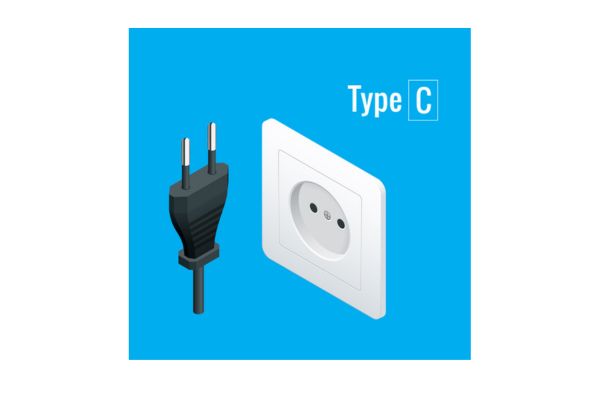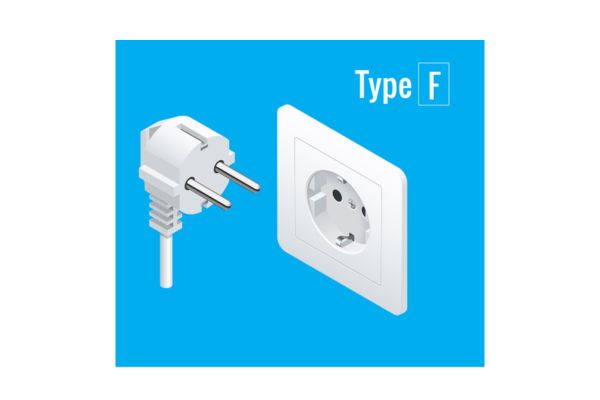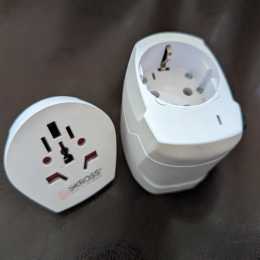It’s the same question we ask before we finally pack the bags, or set off across a border. “What plug adapters do I need in Moldova?” Moldova isn’t exactly the first place that pops into your head when you’re packing up your chargers, but trust me, getting this sorted before you arrive saves a lot of hassle. I’ve scrambled before at hotel receptions and airport kiosks for adapters, and it’s never fun. So here’s my guide to everything you need to know about Moldova’s power adapters. I’ll cover whether you need one at all, what type of plugs and sockets are in use, the voltage, and how to avoid frying your gear. By the end, you’ll know exactly what adapter to pack for Moldova.
THIS POST MAY CONTAIN COMPENSATED AND AFFILIATE LINKS MORE INFORMATION IN OUR DISCLAIMER
Our trip to Moldova was last minute, but that doesn’t change the fact that the practicalities are important. Coming from the UK, I’m always aware that our plugs are pretty much oddballs compared to the rest of the world, . Moldova? Different again.
TOP PRODUCT PICK
This fabulous adapter will cover you no matter where you’re from. And it’ll cover you wherever you’re going to.
The quick answer is simple: in Moldova, you’re looking at sockets with two round holes — so you’ll need a plug with “two fat round prongs.” That’s the Type C or Type F plug. If you’ve traveled through much of mainland Europe, you’ll recognize these straight away.
If you just want the short version, that’s it: two round pins and you’re good to go in Moldova. But if you want the details — voltage, frequency, and which devices will work without extra kit — then read on.
PRACTICAL TRAVEL TIPS
- 🛡️ Get Travel Insurance: Civitatis includes medical expenses, repatriation, theft, luggage delays. No deductibles or upfront payments. Get a quote here.
- 💰 Read about the Currency in Moldova and ATM fees.
- 🔌 Check out Moldova’s plug, socket & power situation.
- 📶 Internet, maps and data on the go. eSims for Moldova
What’s the Electricity Supply like in Moldova?
In Moldova, the electricity supply runs at 230 volts with a frequency of 50 Hz. That’s the same setup you’ll find across most of Europe. If you’re coming from the UK or anywhere else in Europe, this won’t be news to you. If you’re traveling from the United States or Canada though, it’s a very different story — you use 120 volts back home, so the voltage here is almost double.
Most modern devices are designed for international travel and are already dual voltage (look for the tiny writing on your charger that says “Input: 100–240V”). Phones, laptops, cameras, tablets — they’re all usually fine with Moldova’s supply. What you need is simply the right plug adapter to get them into the socket.
What you don’t need — unless you’re dragging around a hair straightener, curling iron, or an old-school single-voltage appliance — is a voltage converter. They’re heavy, pricey, and not worth the space in your bag. Hotels in Moldova almost always have hairdryers anyway, so I’d save myself the weight and leave converters behind.
I carry the same universal adapter I’ve used across 120 countries now — it works in Moldova and about 200 other countries. It doesn’t convert voltage, but it does let me plug in my gear without issue. That’s usually all you need here.
What plug adapter do I need in Moldova?
Moldova uses two types of plugs, Type C and Type F. They both look very similar — two round pins — but the Type F has earthing clips on the side. You’ll come across both types of sockets here, but either style will accept both types of plugs.
Plug Type C has two round pins. A Type C plug looks like this, and a Type C socket looks like this.

Plug Type F also has two round pins but with those extra earthing clips. A Type F plug looks like this, and a Type F socket looks like this.

For anyone arriving from the UK, USA, or Canada, your plugs won’t fit into Moldova’s sockets. You’ll need a travel adapter to connect your devices. I’ve used the same universal adapter for years — it’s compact, works in more than 200 countries, and covers Moldova without any fuss.
Do you need a voltage converter in Moldova?
For most travelers, the answer is no. Moldova runs on 230 volts, and the majority of modern devices are built to handle a voltage range of 100 to 240 volts. That means your phone, laptop, tablet, and camera charger will all work fine here with just a plug adapter.
Where you might run into problems is with older or single-voltage appliances. Hair straighteners, curling irons, or other heating devices are the usual culprits. If they’re only rated for 110 or 120 volts, plugging them straight into a Moldovan socket could burn them out.
The best thing to do is check the label on your device. If it says “Input: 100–240V,” you’re safe to use it in Moldova. If it only lists 110 or 120 volts, then you’d technically need a voltage converter.
What is the recommended plug adapter for Moldova?
The best plug adapter for Moldova is one that works with both Type C and Type F sockets. If you’re already carrying a European adapter, chances are it will do the job here without issue.
If you want peace of mind, pick an adapter that includes USB ports too. It means you can charge a couple of phones or a tablet directly, without needing extra plugs or chargers. For a trip through Eastern Europe where countries use different socket shapes, a universal adapter really is the simplest solution.
MOLDOVA TRAVEL RESOURCES
AIRPORT TRANSFERS
24/7 pickup & drop off. Trusted, local English speaking drivers. Prebook & prepay online with cards.
Book a Transfer
HOTELS AND APARTMENTS
See choices here
Rooms with a view? Budget rooms? Need a washing machine? The best choice of hotels & apartments.
TOURS & ATTRACTIONS
Most excursion choices, small group tours, skip-line tickets, free cancellation and top local guides.
Top options here.
CAR RENTAL OPTIONS
Choose cars here
Best choice of vehicles, automatics, large or small cars, child seats. Book early for more options.
Final Words on Moldova Power Adapters
If you’re traveling to Moldova from the UK, USA, Canada, or anywhere outside mainland Europe, then yes — you’ll need a plug adapter. Moldova uses the standard European two-pin setup, with Type C and Type F sockets. Travelers arriving from Central or Eastern Europe won’t need to worry, since it’s the same style used across much of the continent.Pack a good quality travel adapter — ideally a universal one if you’re visiting multiple countries — and you’ll have no trouble charging your devices in Moldova. It’s a small piece of kit, but it makes life much easier once you’re here.
ASocialNomad is a participant in the Amazon Services LLC Associates Program, an affiliate advertising program designed to provide a means for sites to earn advertising fees by advertising and linking to amazon.com, amazon.co.uk, and amazon.ca. Amazon and the Amazon logo are trademarks of Amazon.com, Inc. or its affiliates. As an Amazon Associate, I earn from qualifying purchases.



